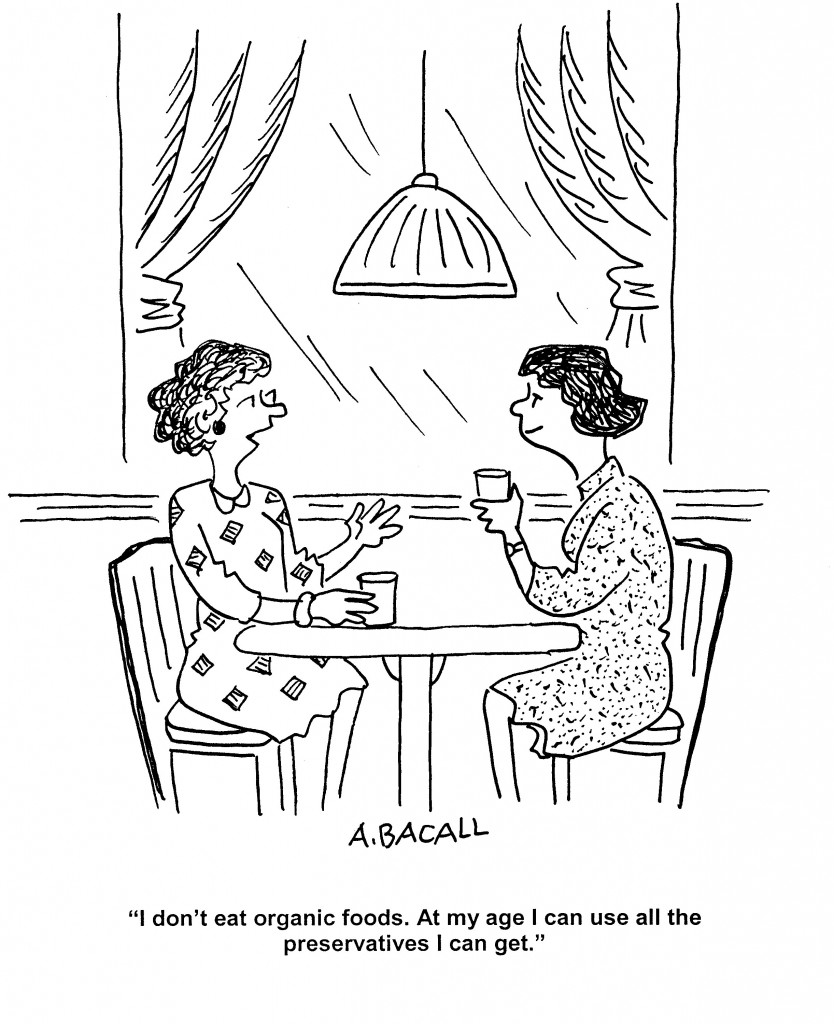Wednesday Bubble: The Magic Menopause Ball
 Can you accurately pinpoint the timing of your final menstrual period? Lord, I finally hope so because if you are anything like me, 50+ and over this bleeding thing, the ability to read into the magic menopause ball sounds like heaven. However, more importantly, it may have significant benefits for women’s health overall. For example, knowing when you will enter menopause provides you with the ability to address bone loss and other risks now (the rate of bone loss greatly accelerates to roughly 2.6% in the year prior through two years after menopause). And there’s no time like the present to start bolstering your defenses against the health-related ravages of aging.
Can you accurately pinpoint the timing of your final menstrual period? Lord, I finally hope so because if you are anything like me, 50+ and over this bleeding thing, the ability to read into the magic menopause ball sounds like heaven. However, more importantly, it may have significant benefits for women’s health overall. For example, knowing when you will enter menopause provides you with the ability to address bone loss and other risks now (the rate of bone loss greatly accelerates to roughly 2.6% in the year prior through two years after menopause). And there’s no time like the present to start bolstering your defenses against the health-related ravages of aging.
This post comes with a warning: it’s a bit geeky science-y. Some topics are harder than others to write about. However, I hope that you’ll bear with me and read on; it’s important.
This is not the first time that the future is being explored; you may recall another test that measures the antimullerian hormone, an ovarian marker that relates to the number of immature follicles a woman has (as the marker declines, so do the number of eggs a woman houses, and the closer to menopause she is). Another way to gauge the start of menopause is to monitor bleeding patterns. Not only is this onerous, but, data suggest that more than 60% of women in early perimenopause become postmenopausal with no apparent signs.
A new approach to pinpoint the timing of menopause involves a calculation of changing levels of estradiol (the most important form of estrogen in the body) and follicle stimulating hormone (FSH – the hormone produced by the pituitary gland that stimulates the ovaries to produce eggs). The closer a woman is to menopause, the higher the FSH levels and the lower the estrogen levels. To determine if this test is valid, researchers developed a model based on data collected from 574 women in the ongoing Study of Women’s Health Across the Nation (SWAN). These women were all between the ages of 42 and 53, had an intact uterus and at least one ovary and were not taking hormones. They were ethnically diverse (Caucasian, African-American and Asian) and had given blood samples over a ten year period.
The findings? After adjusting for factors that might influence menopause, including age, smoking and weight, they found that measuring FSH and estradiol could accurately pinpoint three major timepoints: roughly two years and one year prior to the final menstrual period and the final menstrual period. Moreover, the ability of the test to predict the final period increased as women moved closer to the goal.
Now, scientists use variables to gauge how well a test can predict the number of people with a condition (sensitivity) as well as how well a test can identify those people without the condition (specificity). The new model was shown to be able to accurately identify 89% of women who reached their final menstrual period, which is excellent.
Scientific mumbo jumbo aside, the upshot is that it’s likely that we’ll be able to predict the date of our final menstrual with great accuracy in the near future. Better than an 8-ball. The answer is ‘Yes.’
[This study appears in the April 2013 issue of the Journal of Clinical Endocrinology and Metabolism.]
Read MoreIso what? Iso who? Hot flashes, isoflavones and clinical trials
 I’ve long been intrigued by the replacement of hormone replacement therapy with soy isoflavones. Yet, studies looking at their effectiveness for alleviating hot flashes and other vasomotor symptoms have been mixed. The reasons for this are multiple, and point to such factors as dose and actual composition of the supplements used, severity of hot flashes and how often women are taking isoflavones over the course of the day. Researchers have also discovered that only 20% to 30% of Westerners produce equol, (there’s even a dispute over this stat) a component of the potent isoflavone dadzein that has an affinity for estrogen and appears to be slowly cleared from the body;(note that both of these factors contribute to its beneficial effect against flashes.
I’ve long been intrigued by the replacement of hormone replacement therapy with soy isoflavones. Yet, studies looking at their effectiveness for alleviating hot flashes and other vasomotor symptoms have been mixed. The reasons for this are multiple, and point to such factors as dose and actual composition of the supplements used, severity of hot flashes and how often women are taking isoflavones over the course of the day. Researchers have also discovered that only 20% to 30% of Westerners produce equol, (there’s even a dispute over this stat) a component of the potent isoflavone dadzein that has an affinity for estrogen and appears to be slowly cleared from the body;(note that both of these factors contribute to its beneficial effect against flashes.
Despite these challenges, what would happen is you simply upped the dose and/or frequency? Would it change the’ iso what’ or ‘who’ to an actual ‘iso yes!?’
That’s exactly what researchers sought to learn when they recruited 130 peri- and post-menopausal women with severe hot flashes (i.e. five or more a day). Women who produced equol and those who did not were separated and then randomly asked to take placebo, low dose (33 to 66 mg/day) or high dose (110-200 mg/day) equol or placebo capsule (s) and take them once daily or two to three times daily. They also kept daily hot flash diaries, assessing each hot flash by its intensity, daytime or nighttime occurrence and how bothersome they were. They met with the research team face to face twice — 9 weeks in, and 3 weeks after the study completed.
The findings made it quite clear that dose and frequency are almost as important as whether or not a person is able to produce equol. In fact, when women took higher doses of isoflavones more frequently, they had 2.4 per day fewer hot flashes than women taking the lower doses just once a day. And, the flashes were significantly less severe. What’s more, most of these benefits were realized during the night, when, as most of us know, flashes and sweats are especially disruptive. Moreover, there was not much of a difference between women who are able to produce equol and those who are not; while these women did experience greater declines (as much as 10%) in both how intense their flashes were and how frequently they occurred, the difference was apparently not statistically significant.
So, let’s cut through the scientific clutter:
- Higher doses of isoflavones tend to have a greater effect than lower doses
- More frequent dosing (two to three times a day) appears to be more beneficial than once a day dosing.
- Greater benefits are likely to be seen in women who naturally produce equol, especially when it comes to hot flash intensity
- Both perimenopausal and menopausal women may potentially benefit from higher, more frequent dosing.
This type of research is just beginning and the findings need to be teased out in larger numbers of women. It’s also unclear if spreading the lower dose out throughout the day would make a difference. Still, what these findings do bring to light is an evolution of thinking and that’s what makes me most excited. Rather than determining that isoflavones are useless, researchers are finally starting to treat them as though they were pharmaceutical agents, using them in randomized clinical trials, varying doses, frequency and patient populations and truly, thinking outside the box.
Read More
Still feeling like a shadow of your former self?
Must be “Low T,” right?
Low T is a global problem of epic proportions. In fact, UK researchers are reporting that testosterone prescribing has reached epidemic proportions, with an increase in prescriptions by almost 90% between the years 2001 and 2010. Moreover, the majority of these prescriptions have not been for an established hypogonadism (a decline in the functional ability of the testes to produce ample amounts of testosterone. This can lead to erectile dysfunction, low libido and a low sex drive. Aside from sexual dysfunction, hypogonadism can also cause depression, lethargy and fatigue. And yet, the most recent statistics from the Urology Care Foundation suggest that low T is a problem mostly affecting men 60 and above. In the UK study, only 6.3% of men had definite hypogonadism. So, what gives?
Money.
A few years ago, the pharmaceutical industry jumped on the male menopause wagon and the current campaign is a doozie. The condition? Low T, which is better known as low testosterone, andropause or the commonly used misnomer, “male menopause.” In fact, you can take a simple quiz to learn if you have Low T and if you need to speak to your doctor.
I’ve written about male menopause and have also directed readers to data that shows that it may not be all that it’s cracked up to be. Is it irritable male syndrome? Or is it another marketing tool to sell drugs to unsuspecting men who are aging and losing their virility?
Truly, if you are feeling like a shadow of your former self, there may be other things at play than testosterone. You might want to speak to your healthcare practitioner before jumping on the Low T wagon. Too much testosterone can lead to heart disease and negatively affect the prostate gland.
The medical community remains unconvinced about the condition and the need to treat it. In fact, that might be why, in 2011, University of Pennsylvania researchers started putting it to the test with the T Trial, which may solve this question once and for all.
Read MoreWednesday Bubble: HRT. One Size Does Not Fit All
When it comes to medical strategies, one size never fits all. Dosages and directions for use need to be individualized. Genetic factors, current health status, age, diet, exercise and weight play important roles. As do total health outcomes.
Earlier today, I was reading an article* for a project that I am working on and ran across the following sentence:
“Clinicians are interested not only in improving symptoms, but also in total outcomes, i.e. changes in patients’ current and future health due to effects of treatment.” The author, Dr. Michael Blaiss, goes on to explain that not only is the clinical response important, but also, quality of life and cost should be taken into consideration.”
I can think of nowhere where this statement is more important than in the treatment of menopausal symptoms. One size, indeed, does not fit all. Therapeutic strategies should be individualized and address a woman’s specific symptoms, her age, her current menopausal status, smoking history, health history, diet, genetics and preferences. A single tablet is no more the answer than a standardized dose of hormone replacement therapy (or menopausal replacement therapy — MHT — as it is called in other developed nations).
Recently, a group of organizations** devoted to menopause, reproductive medicine and endocrinology convened to issue a new statement about the use of hormonal therapy during menopause. To be entirely honest, this is the first time that I’ve believed such a statement is without bias and was not driven by pharmaceutical interests. It also appears to reflect the total outcomes concept. And so, I wanted to share a summary of a few key recommendations so that you can make an informed decision about addressing your menopausal symptoms.
- Menopausal Hormone Therapy or MHT is [one] of the most effective treatments for vasomotor symptoms but benefits are likely to outweigh risks [only] before age 60 or within 10 years after menopause. It is also effective for prevention of osteoporosis-related fractures in at risk women but again, only before age 60 or within 10 years after menopause.
- While estrogen alone may decrease the risk of heart disease and death from heart disease in women under age 60 (again within 10 years of menopause), similar evidence for combined hormone replacement in terms of heart disease has been found. It neither prevents or increases the risk of heart disease.
- Vaginal dryness? Try local estrogen and not systemic; it is preferred.
- The risk of stroke increases with MHT; patches may offer lower risk.
Contrary to widespread data, the organizations continue to dispute the connection between breast cancer and MHT, however, they do emphasize that current safety data do not support the use of MHT in breast cancer survivors. Finally? the consensus statement emphasizes that the decision to use MHT is complex and must take certain factors into account, factors such as quality of life, health priorities and personal risk factors. Dose and duration must also be individualized, consistent with goals, and in consideration of safety issues.
If you want to learn more about HRT and its risks/alternatives, I’ve been writing about the issue and the data for almost five years now. You can start perusing the archive of information here. Meanwhile, be smart, be vigilant, ask questions. Don’t accept the idea that a pill or a single solution exists; it probably doesn’t. And mostly? Keep the faith. I’ve got your back. Promise.
*Blaiss MS. Cognitive, social and economic costs of allergic rhinitis. Allergy and Asthma Proc. 2000;21:7-13.
** The American Society for Reproductive Medicine, The Asia Pacific Menopause Federation, The Endocrine Society, The European Menopause and Andropause Society, the International Menopause Society, the International Osteoporosis Foundation and the North American Menopause Society.
Read More








